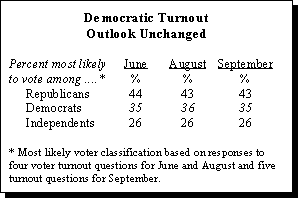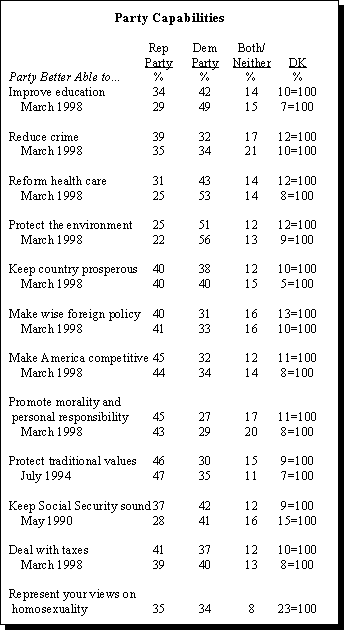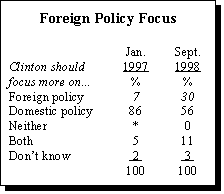Congressional Ballot Remains Close
Republicans have not garnered a big boost with voters from either the ongoing Clinton scandal or the recent upswing in the GOP’s image. Support for the two parties remains split both among registered voters (45% Republican vs. 46% Democrat) and the more narrowly-defined group of most likely voters (48% Republican vs. 45% Democrat).
 But at 46%, support for the Democratic ticket is down substantially from this year’s high of 52% among registered voters in March. The drop in support for Democrats is greatest in some of the party’s core constituencies, including low-income voters (down 10 percentage points).
But at 46%, support for the Democratic ticket is down substantially from this year’s high of 52% among registered voters in March. The drop in support for Democrats is greatest in some of the party’s core constituencies, including low-income voters (down 10 percentage points).
The outlook for voter turnout also continues to favor GOP prospects. Some 43% of Republicans fall into the most likely to vote category, compared to 35% of Democrats and 26% of Independents.(1) At the same time, there are no signs that the scandal has dampened interest in voting among Democrats, as the percentage likely to go to the polls remained unchanged from June.
Indeed, fully 63% of voters continue to say Clinton will not be much of a factor in their vote. One-third of voters (34%) say state and local issues will make the biggest difference in their choices on Election Day, while nearly as many say the candidate’s character and experience (33%) as well as national issues (22%) will be factors. Party control of Congress will be a consideration for 41% of voters.
Overall, Congress gets higher marks than in recent months. Two-thirds (66%) of the public has a favorable opinion of Congress, up from 50% a year ago. Some 46% of registered voters would like to see most members of Congress reelected this fall (compared to 36% who would not), and 63% want to see their own representative returned to office.
Party Images
Americans view the Republican Party in a better light than they did six months ago. The party’s overall image has improved among all demographic groups, with pronounced jumps among senior citizens and Easterners. In March, seniors gave the Republican Party somewhat negative ratings (42% favorable vs. 48% unfavorable). Now, older people are solidly on the side of the GOP: 55% view the party favorably, 36% have an unfavorable impression. Similarly, while only 46% of Easterners viewed the GOP favorably in March, now fully 61% do.
Opinion of the Democratic Party remains basically unchanged. Fully 60% of the public rates the party favorably; in March, 58% did so.
However, the GOP’s improved image has cut into the public’s support of Democrats in the policy arena. Americans’ confidence in the Republican Party’s ability to handle a variety of issues has either risen or remained steady across 11 areas. At the same time, the public has less confidence in the Democratic Party on several of these issues.
This Republican gain and Democratic loss is particularly pronounced for education, health care and Social Security, areas that traditionally favor Democrats. While the public still expresses relatively more confidence in the Democrats, their margin of support is less than half of what it was just 6 months ago. Americans opt for the Democratic Party over the GOP by just 8 percentage points for education and 12 percentage points for health care. In March, these margins were 20 and 28 percentage points, respectively.
 Republicans have also made inroads into impressions of which party is better able to keep the Social Security system financially sound. In 1990, 41% of Americans favored the Democrats on this issue, compared to 28% who had more faith in the Republicans. Now, the gap is a slim 5 percentage points, with 42% placing more confidence in the Democratic Party and 37% favoring the GOP.
Republicans have also made inroads into impressions of which party is better able to keep the Social Security system financially sound. In 1990, 41% of Americans favored the Democrats on this issue, compared to 28% who had more faith in the Republicans. Now, the gap is a slim 5 percentage points, with 42% placing more confidence in the Democratic Party and 37% favoring the GOP.
Moreover, Republicans have gained an advantage with the public on crime. Americans favor the GOP by a margin of 39%-to-32%; in March, they had equal confidence in the ability of the two parties to deal with the issue.
As with the party’s overall image, it is the movement of senior citizens to the GOP camp that is most striking. In March, senior citizens expressed more confidence in the Democratic Party over their Republican rivals by margins of 50%-to-20% for improving education, 49%-to-22% for reforming health care and 32%-to-21% for reducing crime. Now, the Democratic advantage among seniors has narrowed to 37%-to-30% for education and 39%-to-28% for health care. It has disappeared altogether for crime (30% favor GOP vs. 30% for Democrats).
On Voters’ Minds
The White House scandal has clearly moved to the forefront of the public consciousness. Fully 46% of Americans say they discuss the allegations frequently with family and friends. And, among those who are dissatisfied with the course of the country, the Clinton scandal and the broader issue of morality are their top concerns. One-in-five Americans (19%) volunteer the president’s current troubles as the reason they are dissatisfied with the way things are going in the country today. A similar proportion (18%) point to the nation’s moral crisis. The economy topped the list of complaints in 1995 and 1996. Today, it is a distant third behind these moral concerns.
 Fully half of Americans say they frequently discuss declining moral standards with family and friends, ranking it first on a list of 13 issues in the poll ranging from crime to the coming of the millennium. Education follows morality as the most talked about issue: 48% discuss it frequently. Close behind is the Clinton scandal. Other popular issues are health insurance and HMOs, crime, terrorism, and taxes.
Fully half of Americans say they frequently discuss declining moral standards with family and friends, ranking it first on a list of 13 issues in the poll ranging from crime to the coming of the millennium. Education follows morality as the most talked about issue: 48% discuss it frequently. Close behind is the Clinton scandal. Other popular issues are health insurance and HMOs, crime, terrorism, and taxes.
Republicans place much more emphasis on morality and the Clinton scandal than do Democrats. Fully 63% of Republicans discuss morality frequently compared to 42% of Democrats; 59% of Republicans discuss the scandal vs. 39% of Democrats. A similar pattern can be seen between likely midterm voters and nonvoters, with voters much more focused on the moral issues.
Heightened concern about moral issues has not affected the public’s issue agenda. When asked what one issue they would like to hear the candidates in their state or district talk about, education tops the list, followed by taxes, crime, the economy and health care. This is largely unchanged from June.
No Gender Gap for Gore
Early preferences for the 2000 presidential election carry bad news for Democrats — especially for Vice President Al Gore. Although the vice president’s 57% favorability rating remains largely unchanged from earlier this year, Gore trails Texas Governor George W. Bush in voter preference for the next presidential election by a 53%-to-40% margin.
 The presidential race is much closer when voters are simply asked to choose between a Democrat and a Republican, rather than between party frontrunners Gore and Bush. Given the choice of party only, 43% favor a Democratic candidate and 42% pick a Republican.
The presidential race is much closer when voters are simply asked to choose between a Democrat and a Republican, rather than between party frontrunners Gore and Bush. Given the choice of party only, 43% favor a Democratic candidate and 42% pick a Republican.
Notably, the prospect of a Bush candidacy eliminates the gender gap that traditionally boosts Democratic candidates. Bush enjoys a slight edge over Gore among women (48% vs. 44% favoring Gore), even as women support a generic Democrat over a Republican by a 47%-to-38% margin.
Selected Tables





